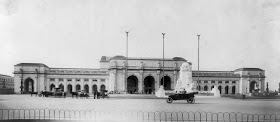Paul M. Weyrich, of the Free Congress Foundation, is a fan, not only of rail transportation, but also of neoclassical architecture, as evidenced here: A Celebration of Railroads and Architecture. I am completely in agreement with him in his advocacy of train travel, which I am convinced needs to be favoured over air travel for short and intermediate distances. I am more ambivalent over his sweeping claim, following Prince Charles, that "classical architecture is a tribute to God Almighty."

Union Station, Washington, DC
I have been to Washington's Union Station at least twice, most recently in July of last year. It was designed by architect Daniel Burnham, well known for his contribution to the World's Columbian Exposition in 1893 and his Plan of Chicago in 1909. I am pleased that this magnificent structure was successfully preserved and restored. Furthermore, I am happy to admit that all architecture is in some fashion a manifestation of God's creative intent that his image-bearing creatures should shape their environments in distinctive ways.
Yet architectural fashions also reflect the religious worldviews of the architects themselves, as well as of the larger culture that nurtures them. One looks in vain for Weyrich to recognize that neoclassicism in art and architecture was motivated by an effort more to recover the vaunted glories of pagan Greece and Rome than to honour God. Weyrich's conservatism could stand to be a bit more nuanced here.
No comments:
Post a Comment